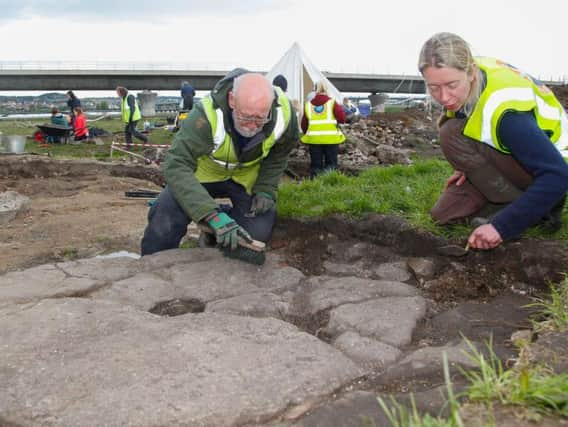Airth archaeological dig sheds more light on royal dockyards connection


Archaeologists, geographers, historians and volunteers working on the Hidden Remains of Higgins Neuk project say they have found “intriguing evidence” that some of the biggest ships in Europe were maintained and repaired at the site, which lies beside the Clackmannanshire Bridge, during the reign of King James IV.Led by historian John Reid, who has researched the dig area for 30 years, the project is run as part of the Inner Forth Landscape Initiative and involves Scottish Coastal Archaeology and the Problem of Erosion (SCAPE) archaeologists, University of Stirling geographer Richard Tipping and Falkirk archaeologist Geoff Bailey.The team has been working together for three years and while it is still unable to confirm for definite whether or not the site dates back to this period, the latest investigation produced a series of new discoveres which have shone yet more light on its history.Coring, geophysics, metal detecting, drone surveys and archaeological excavation techniques helped add some key pieces to the historical jigsaw.Among the discoveries were the foundations of mill buildings next to the channel, old millstone reused as part of a paved surface, a corn-drying kiln, a sea wall and posts of an old wooden pier.The flagship of King James IV’s navy, the Great Michael, was allegedly the largest vessel on the continent when launched in 1511 and was docked at the site several times for repair work. The second ship of the Navy, the Margaret, named after King James’ queen, Margaret Tudor, was about the size of the Mary Rose and both ships are thought to have sailed into the docks before setting off to the Battle of Flodden in 1513.And, from the 1600s, a series of mills once harnessed the power of the Pow Burn to produce their goods, while a ferry used to cross the Forth and travel between Airth and Kincardine. The team believes the well-built stone sea wall which encloses a stretch of the riverbank is a sign of significant investment in this area.Elinor Graham, University of St Andrew’s and SCAPE Trust archaeologist, thanked all those who have dedicated time and effort into learning more about a site which could potentially hold international significance. She said: “The objective was to investigate the history and archaeology of the site of Higgins Neuk and see if we could find the lost dockyard of James IV, built in the early 1500s for fitting out and maintaining the ships of his Royal Navy during his wars with Henry VIII.“Over four seasons of investigation, we’ve had over 50 volunteers, many of whom have come back over and over to the site to use the different techniques (coring, geophysics, metal detecting, drone surveys, and archaeological excavation) we’ve used to investigate the site.“We’ve all had a great time and the volunteers have made a fantastic contribution to uncovering the site’s history.“We’ve learned a lot and although John (Reid) is slightly disappointed that we haven’t definitively proved that the docks are here, he’s pleased with the discoveries we’ve made about the mills, the ferry and the intriguing evidence that there might be evidence of boat-building here.“Most excitingly, we found the edge of the old channel which at its bottom has waterlogged layers which were full of pieces of wood offcuts, which were preserved by the wet conditions. Someone was doing a lot of wood working — maybe boat-building — here.“Although it’s impossible to say for now whether this dates to the right period for James’ docks, we’ve submitted samples of the wood for radiocarbon dating. “We also had a coin from the stone pier, which will need to be looked at by experts but which might give us a date for its construction too.”The team has confirmed it will return to the site if dating results provide evidence that boat-building took place there during the 1500s.Although the most recent investigation didn’t produce concrete proof of their theory, participants learned some invaluable lessons.Elinor continued: “This is a really great piece of local history with its connections to the rest of the area and it really represents the activity that was going on around the Forth — just how important the river was for producing food, harnessing the waterpower for powering mills and using it for transport and communication.“The sea wall and pier are lovely structures and major pieces of engineering — that sea wall especially is a major piece of infrastructure that someone invested a huge amount in. It took a lot of time, money and effort to build.“If this is the site of the dockyards it’s of international significance. “This is where Scotland’s navy was based during the wars with Henry VIII, where they set off from to the Battle of Flodden, which was a turning point in British history. “The connections are international.“With the Scottish alliance with France against England, French shipwrights were sent over to help build the ships.“The construction of the ships also impacted the immediate and wider landscape, with huge supplies of food and provisions for the ships coming here from all over, and the decimation of Scotland’s woodlands for timber.”